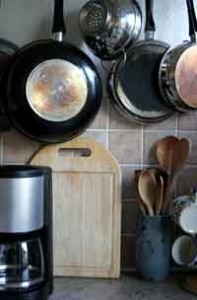Family
Feature
Commentary: Our Bodies, Our Homes

I recently spent two nights with my sister and her husband, Joshua Cahan, at a private beach house on the Pacific. The trip was a long time in planning, but as we were loading the cars outside my Palo Alto home, I realized we had forgotten to discuss an important issue: What would Josh eat? A Conservative rabbi and a Talmud scholar, Josh is deeply passionate abouthalakha. I could guarantee that the ingredients of our meals would be kosher, but would he be O.K. if we prepared these kosher ingredients in the rented beach house’s nonkosher kitchen?
“Just bring a few of your own pots,” Josh told me.
“What?” I was horrified. “Put my pots on a treif stove?”
As I scrubbed the grease stains off the beach house stove, hoping to make it kosher before surrendering my pots, I again thought that I would prefer to use the pots at the house. Then I laughed at myself. How could I be comfortable eating food prepared in the beach house’s pots if I did not want my own pots sitting on that stove? Are my pots more holy than my body?
Yet I am not alone in distinguishing kosher-for-my-body from kosher-for-my-home, with higher standards for the home. According to Rabbi Ruth Abusch-Magder, currently the rabbi-in-residence for Be’chol Lashon, a research and community building initiative based in San Francisco, Jews have been making that distinction for centuries. Abusch-Magder is a Jewish historian with special interests in women and food. She claims that long before the days of fast food or time-shares, Jews made a distinction between what she terms “inside food” and “outside food.”
Abusch-Magder’s research focuses on German and German American Jews at the turn of the 20th century. Among these groups, she found that the most traditional Jews avoided outside food, only eating in kosher homes and carrying kosher food with them when they traveled. The food in their travel bags connected them emotionally with their home community and especially with the women who would have prepared the family’s food for their trip. Yet many other Jews did partake of food at non-Jewish homes, allowing themselves a taste of the outside world while knowing that back home, they could count on the comfort of familiar, kosher food.
I often hear halakhic (Conservative) lay people say: “I am comfortable eating such and such, but I don’t bring it into my house because of community standards.” In other words, as Abusch-Magder observed in her research, modern Jews also see food as connecting the community. By holding two standards, one for our bodies and one for our homes, we can sample outside worlds and still keep our homes rooted in a religious one.
But within liberal communities, where standards of kashrut are less defined, I believe kashrut becomes more a form of personal religious expression. A good friend of mine uses nonkosher meat in her kitchen, but was horrified when a guest brought shrimp into the house. She has a beautiful Jewish home, she holds strong to her personal standards and she wants her pots shrimp-free.
My reaction at the beach house was equally personal. The pots I brought were an extension of my family’s kitchen, which is governed by my internal sense of what our Jewish home should be. That inner sense told me my pots should stay off the beach house stove, even when my brother-in-law—a representative of the halakhic community—was telling me not to worry.
Abusch-Magder points out that kashrut has long been an important source of religious expression for women. The halakha was recorded almost exclusively by men—but the women were the protectors of home and kitchen. Halakhically, the final determiner of kashrut is the body. Anything you are willing to eat you should be willing to cook. But spiritually, I find the very center of my Judaism is not my body, it is my home.
Ilana Goldhaber-Gordon, Ph.D., is a rabbinical student at the nondenominational Academy for Jewish Religion in Los Angeles and a fellow at the Conservative Yeshiva in Jerusalem.










 Facebook
Facebook Instagram
Instagram Twitter
Twitter
Leave a Reply